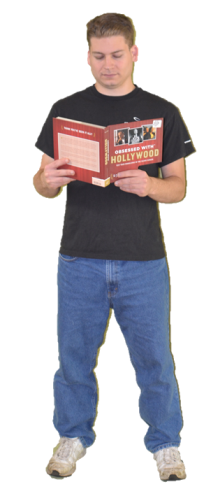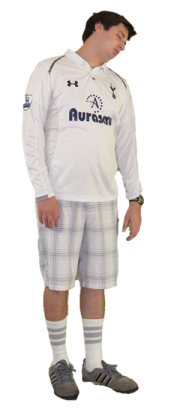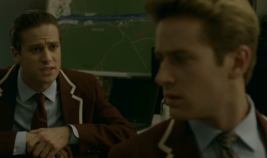 Calm down Ronny, you just blew the World Series twice in a row.
Calm down Ronny, you just blew the World Series twice in a row.

Fourth of July in the USA. While that may mean BBQs, PBRs, and M-80s for the rest of you so-called patriots, it means nothing but remorse and guilt for me. I know the truth, the pain that this heartless nation inflicted upon an entire continent. As such, I spend every so-called “Independence Day” watching the entire Roots mini-series. The fireworks suddenly don’t seem so celebratory when all they do is shine through my bay windows to cast a mockingly colorful hue upon Kunta Kinte’s lash marks, rendered in stunning 480p on my Magnavox plasma set. Don’t worry, black folk. I’m with you. Let whitey enjoy their reign for now. Our time will come. And while you may be tempted to categorize me as “white,” primarily due to my shockingly white skin, do not count me among your former imperialist captors. I have made reparations for my sins many times over, having personally opened 17 KFC franchises in the tri-state area since 1992.
It was going to be just another Fourth full of mental flag-burning, but then I made the quite tragic error of seeing The Lone Ranger. In this Disney movie, we witness scores of the aforementioned white men mowing down the last remaining Indians with Gatling guns. Did you know we kicked the crap out of these people? I sure as hell didn’t. I assumed they were one of the several made up personas for use exclusively in disco sextets. Now I’ve got a real problem. Watching LeVar Burton get mauled for seven hours isn’t going to be nearly enough to quench my hatred for my homeland. Ah, screw it. My race can’t redeem itself from a dual genocide. Might as well join in on the Fourth of July fun. I’ll just go watch another fireworks display and pre-maturely clap on multiple occasions after incorrectly assuming that the show had concluded.
Or, I could just finish up my Lone Ranger review that y’all probably won’t appreciate anyway. Thanks a lot, guys. The eponymous character is portrayed by Armie Hammer, best known to date for playing two-halves of the Winklevi in The Social Network. In that film, Hammer performed admirably, as did most others, and displayed his firm competence as a big screen star. The same could be said of his performance in The Lone Ranger; well done, no complaints. However, while the biggest star in The Social Network was a constipated and irritable Jesse Eisenberg, The Lone Ranger sports an in-form Johnny Depp, playing Tonto, a witty American Indian disowned by his Comanche tribe. Now, the gap between mere star and superstar is apparent. When Hammer and Depp are onscreen simultaneously, every Hammer utterance and action is a straight 2-1 fastball for Depp to knock out of the park. It’s never the other way around.
Depp’s raw skill as an actor is brought out in full force here, skill that was necessary given the physical attributes of his character. Tonto’s face is covered by black and white facepaint for the entirety of the movie, forcing Depp to summon perhaps his greatest gift, that of rendering emotion via the most subtle shifts in his facial expression. The degree of difficulty must have been off the charts, with Depp having to figure out what “perplexed yet intrigued” would look like on his own face, and then transfer that up to the painted version without it appearing over the top or contrived. And by the way, he wears two different faces in the movie; the film is told as a flashback, by a decrepit Tonto forced into the humiliating occupation of being a prop at a Wild West museum in Depression-era San Francisco. Tonto is now sans facepaint, with his skin having nearly melted off, yet you never doubt that they are the same guy. Depp’s Depp-ness shines equally through both Tonto manifestations, with the physical tendencies of both appropriately adjusted for their respective ages.
When Depp is on screen, The Lone Ranger feels like the Pirates of the Caribbean movies, that is, a dark-ish comedy. However, while the Pirates movies never lose sight of the fact that they are fantastical comedies at their core, The Lone Ranger often ventures into pure drama bereft of the light entertainment that the audience expects from a Disney-Depp joint venture. It’s just not good enough though, and whenever Depp exits (which can be for very long stretches), the movie drags like no other. Things were setup for it to be a straight Wild West caper. The villain in the film is Butch Cavendish, portrayed by direct-sales marketing coordinator William Fichtner. He kills John Reid’s (the “Lone Ranger”) brother and kidnaps his wife and child. John, a city-educated lawyer, sets out to track him and bring him to justice. Tonto joins him on the quest, as he is also compelled to track down Cavendish in the hope of redeeming an error that led to him being expelled from his tribe as a child.
Tonto’s backstory, and thus motivations, are not revealed until we’re well into the middle of the movie. This convoluted storytelling pattern is repeated countless times over. We’re introduced to many characters and events, but it’s not clear why we should care at all about them until certain information is brought to light via what the filmmakers would like to think are plot twists. If the boring plot details were simply frontloaded, we could have had a very entertaining (and much shorter) movie that just followed Tonto and the Ranger as they gallivanted around the Wild West on horseback. And that would be a movie worth watching.
The film scores points for looking good, which wasn’t necessarily challenging, as any movie shot in the American West tends to look quite pretty. The most visually stunning sequence is a climactic dual train chase through the pine woods of Utah on a bright spring day. However, this chase may go down as the most incomprehensible, most inexcusably long action sequence in the history of cinema. You would think it wouldn’t be too difficult to keep track of trains, since they more or less have to stay on the track, but these guys couldn’t pull it off. In all of their efforts to cram as many angles of every train car onto the screen as possible, they forgot to factor in the wind. A solid 12% of the movie is comprised of people running on top of fast-moving trains with the hair on the heads barely blowing, and no apparent trouble maintaining their verticality. I tend to think it would be a bit more difficult than they make it out to be.
You shouldn’t see The Lone Ranger in theaters. If it felt like its actual runtime of 2.5 hours, it would be bearable, but it feels more like seven. About halfway in, your mind will start to wander. Personally, to ease my boredom, I started guessing which people in the theater were required by law to introduce themselves to new neighbors. It’s a shame that this movie didn’t work out, because if it did, it would be counted as among Depp’s premier efforts. The best thing to do will be to look for a Lone Ranger Depp mixtape on YouTube, which I will try to put together as soon as I get my Compaq upgraded to Windows Millenium.




